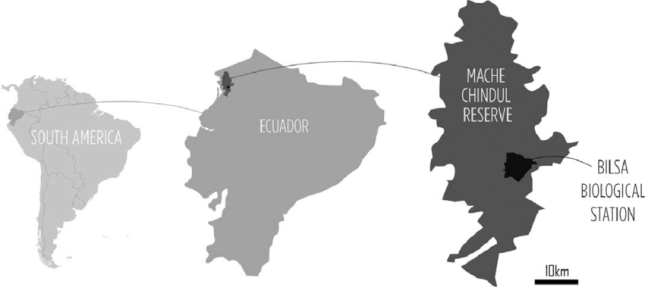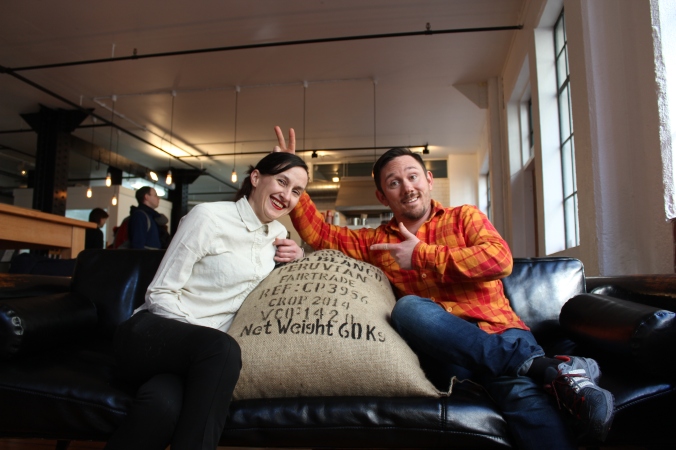Location of Bilsa Biological Station within Mache-Chindul Reserve in Esmeraldas Province, northwest



via Chocolate and the Conscious Consumer – The Mac Weekly
Location of Bilsa Biological Station within Mache-Chindul Reserve in Esmeraldas Province, northwest



via Chocolate and the Conscious Consumer – The Mac Weekly

 The Wellington Chocolate Voyage is now live! Go to our Kickstarter page to become a backer, follow us on Facebook, and help spread the word! By Rochelle and Gabe This is us! Believing in fair trade…
The Wellington Chocolate Voyage is now live! Go to our Kickstarter page to become a backer, follow us on Facebook, and help spread the word! By Rochelle and Gabe This is us! Believing in fair trade…
Bron: A bit about the Wellington Chocolate Factory | The Wellington Chocolate Voyage
link to the Kickstarter page
Chocoladeliefhebbers en fijnproevers kunnen hun smaakpapillen weer strelen tijdens dit unieke evenement rondom origine chocolade. Op 23 oktober 2013 zal voor het tweede jaar het Origin Chocolate Event plaatsvinden in het Koninklijk Instituut voor de Tropen in Amsterdam.
Chocolade: van snoepgoed tot volwassen product
De opkomst van de kleinschalige chocolademakers heeft het product chocolade op een hoger niveau gebracht. Deze chocolademakers verwerken bijzondere variëteiten cacaobonen tot chocolades en weten de meer dan 700 aroma’s in dit complexe product optimaal tot uiting te brengen. Zij behoren tot de prijswinnaars van de gerenommeerde ‘Academy of Chocolate’ en de ‘International Chocolate Awards’.
Werd chocolade voorheen als snoep gezien, hier ervaart u chocolades die zich kunnen meten met de beste soorten koffie en wijnen. Op dit evenement presenteert de crème de la crème van de chocoladewereld haar chocolades en de boeiende verhalen erachter. Onder andere Ecuador, Vietnam en Madagaskar zijn vertegenwoordigd maar ook Kees Raat uit Amsterdam. U proeft zoete en hartige chocolate tapas, de mooiste foodpairings met wijnen, speciaalbieren en thee. Er worden Masterclasses gegeven en Het NH Tropen Hotel biedt tegen een prijs van 39,50 een 3-gangen chocolade diner aan in een van haar prachtige zalen.
Kortom, een evenement waarvan u verrijkt en verkwikt door de theobromine huiswaarts keert.
Waarom het Origin Chocolate Event?
Erik Sauër, importeur van origine chocolades en medeorganisator van het Origin Chocolate Event: ”Origine chocolades zijn gemaakt van cacaobonen uit één specifieke regio, soms zelfs van één specifieke soort. Dit zijn échte streekproducten, met een eigen smaakpallet, die zich onderscheiden van de reguliere chocolades.
Deze chocolades zijn relatief nieuw op de markt en wij willen fijnproevers en chocoladeliefhebbers hiermee bekend maken.
Wat valt er te beleven?
Presentaties en proeverijen van ’s werelds bekendste chocolademakers: Santiago Peralta (Pacari), Bertil Akesson (Akessons), Vincent Mourou & Samuel Maruta (Marou), Philipp Kauffmann (Original Beans), Sepp Schönbächler (Felchlin), Niklaus Blumer en Pascal Wirth (Idilio), Diego Badaro (Amma) en Mikkel Friis Holm (Friis Holm).
Bijzondere ontmoetingen met de meest vooraanstaande chocolade experts ter wereld: Martin Christy (Seventy% Club en International Chocolate Awards), Maricel Presilla (Gran Cacao, chefkok, schrijfster), Clay Gordon (oprichter van http://www.thechocolatelife.com), Anna Laven (cacao expert Royal Tropical Institute).
Verleidende proeverijen van bijzondere cacaosoorten en verfijnde chocolade door o.a. Chocoweb (www.chocoweb.nl) en chocoladewinkel Chocolátl
Exclusieve culinaire hoogstandjes van toppatissiers en chocolatiers: Kees Raat (Metropolitan Deli), Geert Vercruysse (Patisserie Vercruysse) en Alexandre Bellion (Chocolaterie Alexandre).
Wijn-, bier-, whisky- en spijscombinaties met origine chocolade.
Een exclusief ‘origine chocolade’ diner met een bijpassend wijnarrangement.
—————————————————————————————————
Meer informatie over tijden, sprekers en tickets op http://www.originchocolate.eu
Meer over Origin Chocolate
Origine chocolades zijn chocolades van cacao uit een specifieke regio. Kwaliteit, duurzame concepten, biologisch en direct trade zijn kenmerken van de chocolade in deze groeiende markt. Door de beste kwaliteit cacaobonen te gebruiken en zeer veel aandacht en zorg te besteden aan het productieproces, worden de meest aromatische chocolades gecreëerd. Tijdens het evenement wordt de passie van het fijnproeven gecombineerd met het op de kaart zetten van de speciale origine chocolade.
Koninklijk instituut voor de Tropen
Het Koninklijk Instituut voor de Tropen (KIT) is een onafhankelijk kennisinstituut op het terrein van duurzame ontwikkeling, gezondheid, cultuur en kennisoverdracht. Het KIT helpt bedrijven, culturele instellingen, ontwikkelingsorganisaties, overheden en vele andere organisaties in binnen- en buitenland hun doelen te bereiken met hoogwaardige en bruikbare kennis. Er is er veel expertise aanwezig over duurzame cacao en de internationale cacaosector. De samenwerking met het Origin Chocolate Event is een voorbeeld van de overdracht van de ‘know how’ in de cacao industrie naar verschillende doelgroepen.
NH Hotels
NH heeft de ambitie om één van de meest maatschappelijk verantwoorde bedrijven te zijn in de gastvrijheidsindustrie. Het aanbieden van producten en gerechten met een duurzaam karakter, dat is waar NH Hotels voor gaat. Daarom steunt NH Tropen, als gastheer in het KIT, het Origin Chocolate Event.
http://www.originchocolate.eu/
This book explores the knowledge needed for achieving a sustainable cocoa chain and the gatekeepers of thise knowledge. It tells the story mainly from a Dutch perspective, focusing on the knowledge needs of actors involved in cocoa in the Netherlands, and their knowledge partners.
…Fifteen years from now (…) cocoa beans will be transported in the most sustainable way: in mega-bulk ships sailing towards Amsterdam! The port of Amsterdam has introduced a reduced sea harbor tariff for certified beans, to further promote their production and use. Storage and trans-shipment of beans is being done in the most fficient way, as bulk cranes with energy efficient motors and innovative flywheels offload beans. The vermin in the warehouses is eradicated without using environmentally harmful substances. The space in the harbour is also being used as efficiently as possible; as many tonnes as possible have to be used per square meter for trans-shipment and storage. Transport from the warehouses to the processors mainly takes place on barges because of their low CO2 emission and contribution to reducing traffic jams (…)
This story illustrate the vision of James Hallworth, Commercial Manager Bulk Logistics at the Port of Amsterdam, who describing how the cocoa transport storage and trans-shipment in the Netherlands might look fifteen years from now. The Port of Amsterdam is the world’s largest cocoa harbour and the Region of Amsterdam (Zaanstreek) is home to the most complete cocoa network in the world.
This commitment raises a set of questions, regarding the kind of knowledge needed for achieving a sustainable cocoa chain and the gatekeepers of this knowledge. A sustainable cocoa chain involves a process of continuous improvement. How can one ensure that the right knowledge is being developed at the right moment and, in particular, that the available knowledge will be effectively used by the people who need it the most? One must take into consideration the different perspectives on sustainability of the cocoa chain, as well as the different interests covered by the ‘knowledge agenda’, i.e. whose interests are included and whose are left out?
The general aim of this publication on sustainable cocoa in the Netherlands is to examine the question of knowledge and the availability of expertise in the country, and to further compare Dutch cocoa knowledge with the knowledge in the broader international spere. This comparison will serve to identify the strengths and weaknesses of the Dutch cocoa knowledge infrastructure and to provide recommendations for improving its international position.
The publication: This book is part of a wider effort that seeks to achieve sustainable cocoa consuption in the Netherlands within fifteen years (Cocoa that will fall under sustainable cocoa includes for ex. certified organic cocoa, Fair Trade cocoa, Rainforest alliance, and cocoa certified by UTZ CERTIFIED) and to contibute to the global sustainable cocoa economy (people, planet profit). It examens the status of the Dutch knowledge sector and how it can strengthen its knowledge base.The publication aims to present all themes and questions in a way that will do justice to the complexity of the topic, without engaging in in-depth scientific analysis of the subject matter.
Structure of the publication: Chapter 2- Knowledge on sustainable value chains. Chapter 3- The position of the Dutch cocoa sector in the international cocoa chain. Chapter 4- The issues at stake. Chapter 5- Knowledge demand versus supply. Chapter 6- What do the Dutch know? Chapter 7- Recommendations for a sustainable knowledge base.
This is what I learned and wanted to share after seeing the dvd received at the Origin Chocolate Event Amsterdam.
Global standard-setting organisations fro example, organic, Fair-Trade, Utz, 4C, Rainforest Alliance aim to improve the social, envirinmenttal, economic, and health and safety conditions for agricultural productions and processing. These organisations work to continuously improve their standards contributing to sustainable and inclusive value chain development.

The featured film captures key learning and experiences from a workshop on gender equity in global certified coffee, tea and cocoa value chains. It includes interviews with representatives from producer organisations, support services, standard setting organisations and certification bodies as well as the private sector.

Learning session in Kenia on gender & certified value chains.
What are the challenges?
If we look at like certification like organic, the standard that is audited by an organisation like Soil Association, we find that mainly it looks at the good agricultural practices. But when you look further, at the social aspects such as equity and non discrimination plus other social aspects they are not addressed in the standards. And until such aspects have been captured in the standards, thant’s the only written fact that they will be implemented uniformly across of the production sites, wheter in Kenya, Uganda, Tanzania or anywhere else in the world.
So in fact that, as of now, various growers may come up with their own initiatives and implement but that may not be replicated in other growing sites across the various countries where certification is implemented.
“Social issues are not addressed adequately in many global standards.”
Local initiatives can be a source of learning for further development of standards.
Thank to Anna Lavan, research en development of the KIT, www.kit.nl sharing me the DVD Gender&Certfied Value Chains.
Also I would like to share the following www.directcacao.org DIRECT CACAO A new voice for fine cacao and chocolate.
Direct is a new organisation seeking to preserve and protect fien cacao through respect, value and mutual benefit for consumers and chocolate producers.
We believe that the only way to guarantee the future of fine cacao, and so the future of great fine chocolate, is by making sure that the farmers are properly rewarded for the cacao they produce. This can only be achieved through close links between the consumer, chocolate company and cacao farmer.
We aim to create a sustainable cycle based on quality and taste through short-chain Directly Traded fiencacao. We believe taht this is essential for preserving the environment, the livelihoods of farmer and for creating great tasting chocolate.
We NOT believe that ethical labeling schermes can achieve this and in fact can actually be detrimental to a fair and equitable trade in cacao.
Direct Cacao brings together chocolate makers and companies, chocolatiers, cacao growers and companies and independents to begin a new relationship based on a true respect for fine cacao.
Seit zehn Jahren produziert eine kleine Kooperative auf Grenada selber Schokolade. Dahinter steckt ein umtriebiges Duo: Mott Green, ein Aussteiger aus New York, und der Rastafari Edmond Brown. «Fernweh»-Reporter Beat Häner hat sie besucht und ihre Bio-Schokolade probiert.
